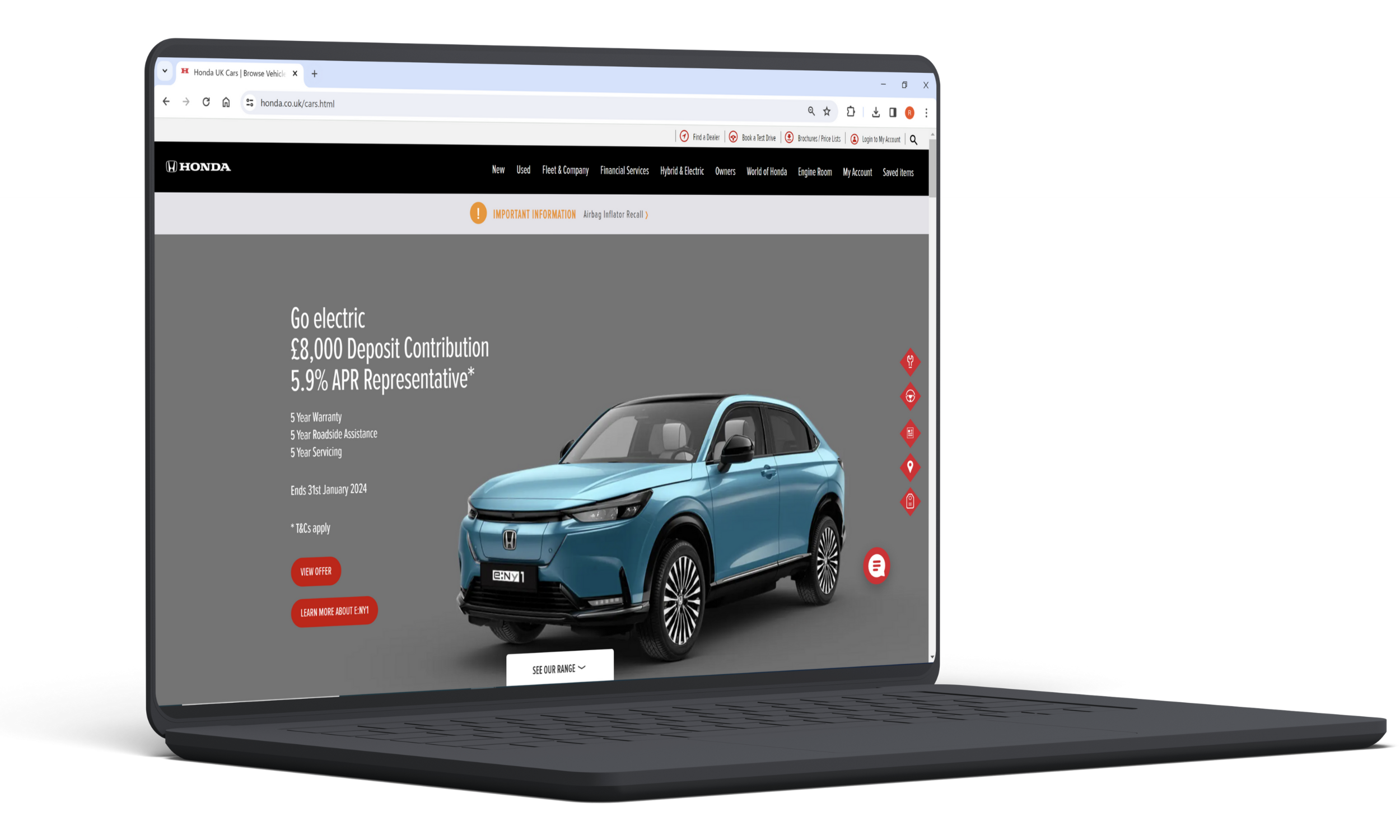Delivering an exceptional website experience is crucial in today’s dynamic digital commerce landscape. Your website serves as the digital storefront where users engage with your brand, products, and services. Every interaction, from clicks to scrolls, influences user perceptions and behaviours. Let’s explore how you can enhance high-value behaviours on your website, drawing insights from successful case studies with some of our esteemed clients.
But first, what exactly do high-value behaviours mean to different companies? For automotive giants like Audi and Honda, these behaviours revolve around actions such as creating an account, configuring a car, and booking a test drive. Similarly, ecommerce powerhouses like Gymshark and Specsavers prioritise activities that boost basket sizes and drive revenue, with a keen focus on metrics like Average Order Value (AOV) and conversions.
Understand the user journey
Crafting a seamless user journey is essential for driving high-value behaviours on your website. By leveraging data-driven insights, you can map out user journeys, identifying touchpoints and pain points along the way. Comprehensive understanding of user needs enables you to anticipate and fulfil expectations, driving meaningful interactions and high-value behaviours.
Optimise the design and navigation
Visual appeal and usability are key components of a positive user experience. From the moment users land on your webpage, they form impressions based on layout, aesthetics, and ease of navigation. Prioritise clear call-to-actions (CTAs), strategic menus, and responsive design elements to guide users effortlessly towards high-value actions, such as making purchases or signing up for services.
Personalisation: Tailoring the experience
Personalisation plays a pivotal role in engaging users and driving high-value behaviours. Harness the power of personalisation to deliver tailored content, recommendations, and offers based on user behaviour and demographics. By serving relevant content, you can effectively engage users and drive conversions, ultimately fostering brand loyalty and satisfaction.
Ensuring functionality: The backbone of digital Customer Experience
Your website’s functionality serves as the backbone of user experiences, ensuring that websites operate seamlessly across devices and platforms. To dramatically increase high-value behaviours, it’s important to conduct thorough functional testing to uncover any issues that could hinder user interactions.
In our collaborative efforts with Direct Wines and Quality Cottages, the significance of functional testing in driving conversions and enhancing user experiences was vividly demonstrated.
During our partnership with Direct Wines, functional testing uncovered 2 critical issues, 19 conversion issues, and 60 Customer Experience (CX) issues plaguing their website. These issues ranged from technical glitches to user interface inefficiencies, impacting user satisfaction and hindering high-value behaviours such as completing purchases.
Upon identifying these issues, Direct Wines promptly addressed them, prioritising fixes based on their impact on customer experience. This proactive approach led to a remarkable 16% increase in conversions, highlighting the critical role of functional testing in optimising website functionality and driving business growth.
Testing turned around in 2 days
Mobile user conversions increased by 16%
Direct Wines was awarded 2019 online retailer by IWC because of their fantastic online experience
2 critical, 19 conversion and 60 CX issues identified
Similarly, our collaboration with Quality Cottages revealed the transformative power of functional testing in improving conversion rates and usability. Quality Cottages, a provider of self-catered holiday cottages in Wales, faced challenges in understanding why their website visitors weren’t converting into customers.
Through comprehensive testing, we identified critical, conversion, and customer experience issues hindering conversion rates. Our testing unearthed a total of 2 critical, 18 conversion, and 102 CX issues, across various browser combinations and operating system platforms. Armed with these insights, Quality Cottages promptly addressed the identified issues, leading to a more than doubling of their conversion rate.
User Acceptance Testing: Validating CX
Beyond functional testing, User Acceptance Testing (UAT) takes the user experience validation a step further. UAT involves real users testing the website under simulated real-world scenarios to assess its usability, functionality, and overall user experience.
In our partnership with Honda, a global automotive leader, they faced a critical challenge in optimising their online presence, particularly the newly launched electric and hybrid car range pages on their UK website. With a need for rapid, thorough User Acceptance Testing, they turned to Digivante for a solution.
Honda’s focus lay in driving high-value behaviours such as booking test drives, configuring vehicles, and increasing online sales. To address this, we conducted a comprehensive package of UAT, which included a meticulous cross-browser test on 25 top devices, usability studies, and accessibility testing.
The results were transformative. We unearthed high-value issues, preventing potential critical impacts on customers. The usability test and accessibility study provided valuable user feedback, enabling Honda to optimise their website to a more intuitive and interactive design. This collaboration led to a surge in high-value behaviours for Honda, most notably increased test drive bookings.

Conclusion
Prioritising the enhancement of high-value behaviours on your website is paramount for achieving business success. By delving into the intricacies of user needs, meticulously refining design elements, tailoring experiences to individual preferences, and rigorously testing for functionality, and user acceptance you can craft a digital environment that seamlessly guides users towards conversion and cultivates enduring brand loyalty. These strategies serve as pillars in the foundation of an exceptional user experience, driving not only short-term gains in conversions but also long-term sustainability and growth for your business.






